air condition CHEVROLET MONTE CARLO 1981 4.G Owners Manual
[x] Cancel search | Manufacturer: CHEVROLET, Model Year: 1981, Model line: MONTE CARLO, Model: CHEVROLET MONTE CARLO 1981 4.GPages: 104, PDF Size: 23.92 MB
Page 20 of 104

Downloaded from www.Manualslib.com manuals search engine SECTION 2
STARTING AND OPERATING
ENGINE EXHAUST GAS CAUTION
(CARBON MONOXIDE)
Do not breathe exhaust gas because it contains carbon monoxide, which by
itself has no color or odor. Carbon monoxide is a dangerous gas. It can cause
unconsciousness and can be lethal.
If
at any time you think exhaust fumes are entering the vehicle, have the cause
determined and corrected
assdon.as possible. If you must drive under. lhese conditions , drive only wilh All windows fully OPEN .
To allow proper operation of your vehicle's ventilation system, keep the.air inlet grille in front of the windShield clear of snow, leaves or other obstructions at all
times.
Protect against carbon monoxide entry into the vehicle body . The best way is to keep the engine exhaust system, vehicle body and body ventilation system
properly maintained. We recommend that the exhaust system and body be inspected by a competent lechniclan :
•
each time the vehicle is raised for an oil change;
• whenever a change is noticed in the sound of the exhaust system;
• whenever the exhaust system, underbody or rear of the vehicle is damaged or. becomes corroded .
See your Miiintenance Schedule folder for parts recuiring inspection.
To allow proper operation of your vehicle's ventilation system, keep the air inlet
grille
in front of the windshi~1d clear of snow, leaves or other obstructions at all
times.
Do not perk or idle this vehicle for more than 10 minutes with the ventilation
system control switch in the "off" position while the engine is running . Even
with
the ventilation system on, running the engine while parked is not recommended . Entry of carbon monoxide into the vehicle body is possible with
a
poorly repaired , damaged, or corroded exhaust system or body.
Do
not run the. engine in CONFINED areas (such as garages or next to a
building) any more than needed to move the vehicle . When Ih.e vehicle has to be stopped in an UNCONFINED area with the engine running for any more
than a few minutes, take the following stepa :
A. Adjust the heating
or cooling ' system to force outside air into the vehicle as
follows:
1. On vehicles not ecuipped wijh air condijioning, set the fan to medium or high speed and the upper control lever to any position except
"Off."
2. On vehicles ecuipped with air conditioning , set the fan to medium or
high speed and the upper control lever to any position except "Off" or
"Max., "
B . Keep the exhaust tailpipe area clear 01 snow and other material to help
reduce the
buildup 01 exhaust gases under the vehicle.
Page 24 of 104
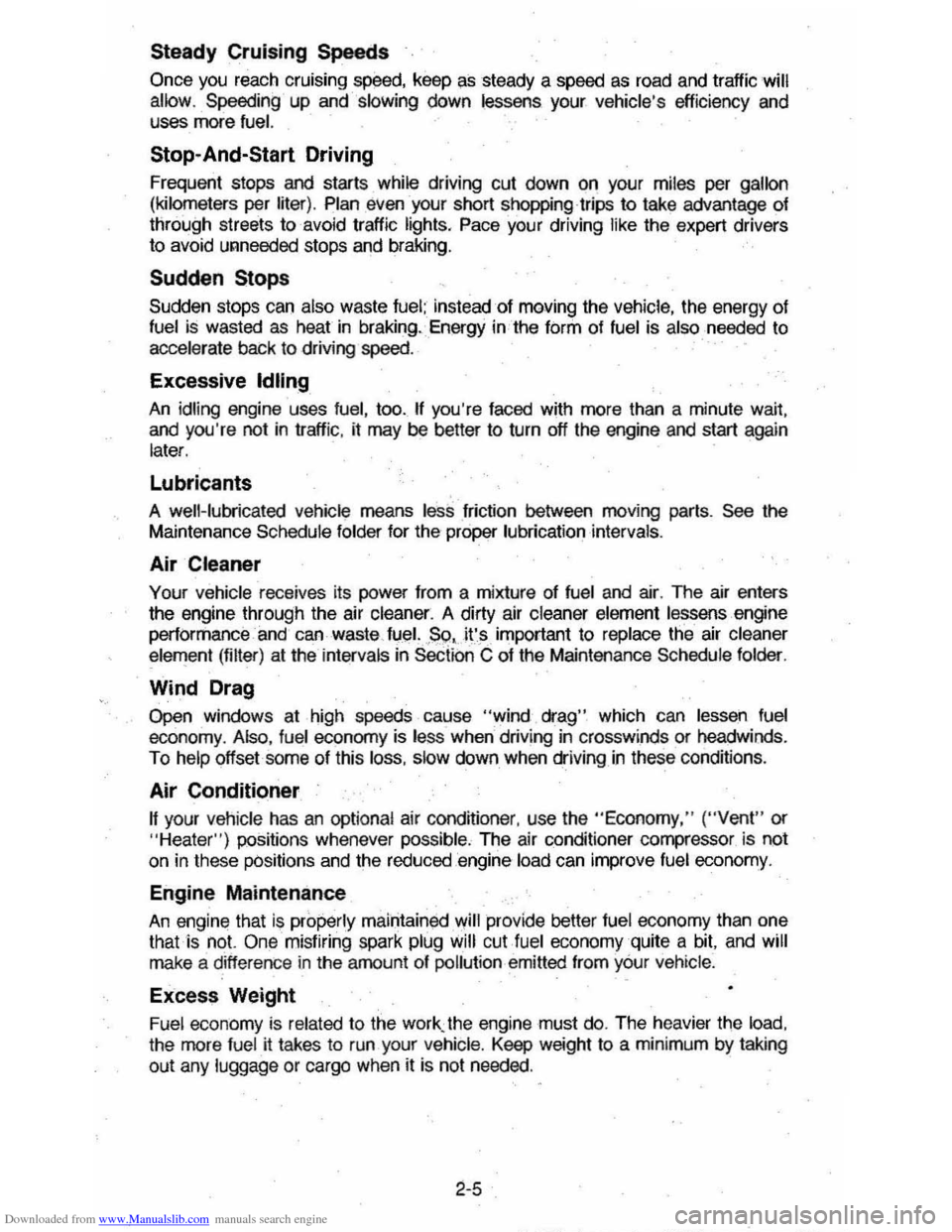
Downloaded from www.Manualslib.com manuals search engine Steady Cruising Speeds
Once you reach cruising sPeed, keep as steady a speed as road and traffic will allow . Speeding up and slowing down lessens your vehicle's efficiency and uses more fuel.
Stop-And-Start Driving
Frequent stops and starts while driving cut down on your miles per gallon
(kilometers per liter) . Plan even your short shopping trips to take advantage of
through streets to avoid traffic lights. Pace your driving
like the expert drivers
to avoid unneeded stops and braking .
Sudden Stops
Sudden stops can also waste fuel; instead of moving the vehicle, the energy of fuel is wasted as heat in braking. Energy in the fOrm of fuel is also needed to
accelerate
baCk to driving speed.
Excessive Idling
An idling engine uses fuel, too .. If you're faced with more than a minute wait,
and you're not in traffic , it may be better to turn off the engine and start again
later.
Lubricants
A well-lubricated vehicle means less friction between moving parts. See the Maintenance Schedule folder for the proper lubrication intervals.
Air Cleaner
Your vehicle receives its power from a mixture of fuel and air. The air enters
the engine through the air cleaner. A dirty air cleaner element lessens engine
perfOrrnance and can waste/Uel. ,So, it's important to replace the air cleaner
element (filter) at the intervals in Section C of the Maintenance Schedule folder .
Wind Drag
Open windows at high speeds cause "wind drag" which can lessen fuel
economy. Also, fuel economy is less when driving in crosswinds or headwinds .
To
help offset some of this loss, slow down when driving in these conditions.
Air Conditioner
" your vehicle has an optional air conditioner , use the "Economy, " ("Vent" or
"Heater") positions whenever possible. The air conditioner compressor, is not on in these positions and the reduced ,'engine-load can improve fuel economy.
Engine Maintenance
An engine that i. properly maintained ."iill provide better fuel economy than one
that is no\.
One misfiring spark plug will cut .fuel economy quite a bit, and will make a difference in the amount of pollution emitted from yOur vehicle.
Exces~ Weight
Fuel economy is related to the work. the engine must do. The heavier the load,
the more fuel it takes to run your vehicle. Keep weight to a minimum by taking
out any luggage or cargo when it is not needed.
2-5
._ - ---_._---'----
Page 29 of 104
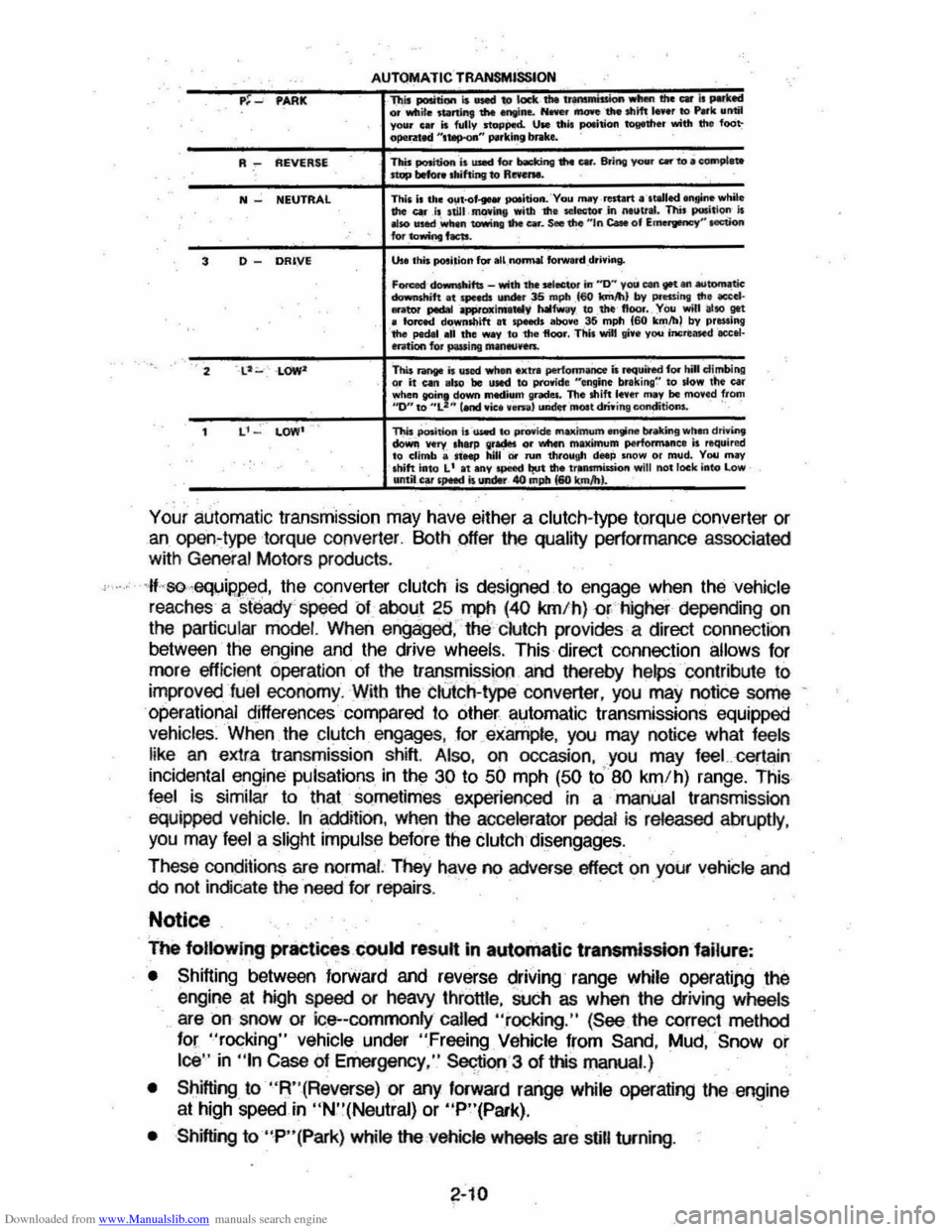
Downloaded from www.Manualslib.com manuals search engine P~ _ PARK
R ~ REVERSE
N _ NEUTRAL
.. '
3 D -DRIVE
L''': LOW' '
AUTOMATIC'TRANSMISSION This position is __ to lock .. u~ ...... the _ islNdted or white JUftInt 1M engIH ......... __ -the Ihift .... r to .... 11. .. Mil YOlir elr is fully stoPped. Use thif; pcIIition 1Otf1h.r with the foot'opel'ded "I~" .,.rlr.lnl b .. ke.
TIllis ,.,.otioR i, UIMI for Ndcing .... Uf. Bti,. yoM _ to.-..I_ nop before doiking to R-. -
This il the ollt-of-9Hf pc)Iltion. YOII may resUr! "ltalled Inginl while the Q)r it uill--II1CWiIIt with the selector ,in 0.1111". Thi. poIitlon is "so !ned wIMfI tawi"" ...
Forced dotonsIoita _ with t~ selector in "0.' you ean fM. an .utotnatic *'-shift It speeds unct.r 15 I'IIptI 100 Ir.mJhl by precsi"l ttle accel· _ator pedIII app,OIIim''' ,Y ..... fw.,. tClthe noar. , You wttJ '''10 get , forced downsnift at 5P"d$ IlboW$ ,35 mph 160 km/h) by prelling 'the pedlll ,II the way to the floor. This will gin you irw.: .. 1INd ace.J· ention for puling 1NnMIftn.
"This Pootnoct i. wed to pcoooide ..,Mimum""'ne brioking wlm! dmint doWiI .... 'Y, .h.rp II'~ or whtn m.ximum perlormanc. is required to climb a It..., hili or run throllgh deep ""OW or mild. You miIY lhift into L' It any tPMd but the trlllrmiS$ion will not loek into Low until_UI' spaid is ~ 40 ,"ph 160 k"""). --c-
Your automatic transmission may have either a clutch-type torque converter or an open,type torque COnverter . Both offer the quality performance associated
with General Motors products.
·~-so·_equipped, the converter clutch is designed to engage when the vehicle reaches a st)lady speed of about 25 mph (40 km/h) or, higher depending on
the particular model. When engagEid, the' clutch providE.s a direct connection
between the engine and the drive
wheels. This direct connection allows for
more efficient operation of the transmission and thereby helps contribute to
improved
fuel economy. With the ClUtch-type converter, you may notice some
operational d,ifferences · compared to other. automatic transmissions equipped vehicles. When the clutch engages , for example, you may notice what feels
like
an extra transmission shift. Also, on occasion, you may feeLcertain
incidental engine pulsations in the 30 to 50 mph (50 to' 80 km/h) range. This feel is similar to that so.rnetimes experienced in a manual transmisSK>n
equipped vehicle. In addrtion, when the accelerator pedal is released abruptly,
you may feel a slight impulse before the clutch disengages.
These conditions are normal. They have no adverse effect on your vehicle and do not indicate the need for repairs . .
Notice
The following practices could result in autoinatic transmission failure:
• Shifting between forWard and reverse driving' range while operati/lg the
engine at high speed or heavy throttle, such as when the driving wheels
are on snow Of ice--commonly called "rocking." (See the corre<:t method
for
"rocking" vehiCle under "Freeing Vehicle from Sand, Mud, Snow or Ice" in "In Case of Emergency," Sectiorl.'3 of this manual.)
•
Shifting to "R"(Reverse) or any forward range while operating the engine
at high speed in "N"(Neutral} or "P"(Park).
• ·Shifting to "P"(Park) while the vehicle wheels are still turning.
2-10
Page 35 of 104

Downloaded from www.Manualslib.com manuals search engine ~
OSTANDARD OOPTIONAL
'"
OPTIONAL
r , ).
1. Fuel Gage 2. Warning Lights 3. Speedometer 4. Hi-Beam Indicotor 5, Odometer 6. Clock 7. Glove Box 8. Wind'shield Wip.r Control 9. Light Switch
10. Rea r Window Defogger Switch 11. Heater and Optionol Air Conditioning Control
m
12. Ashtray 13. Cigarette lighter U. Radio and Control. 1.5. Turn Signal Indicator 16. Tachometer 17, Warning Gages
18. Shift Indicator
19. Check Engine 20 . R.H . Outside Remote Mirror
Page 38 of 104
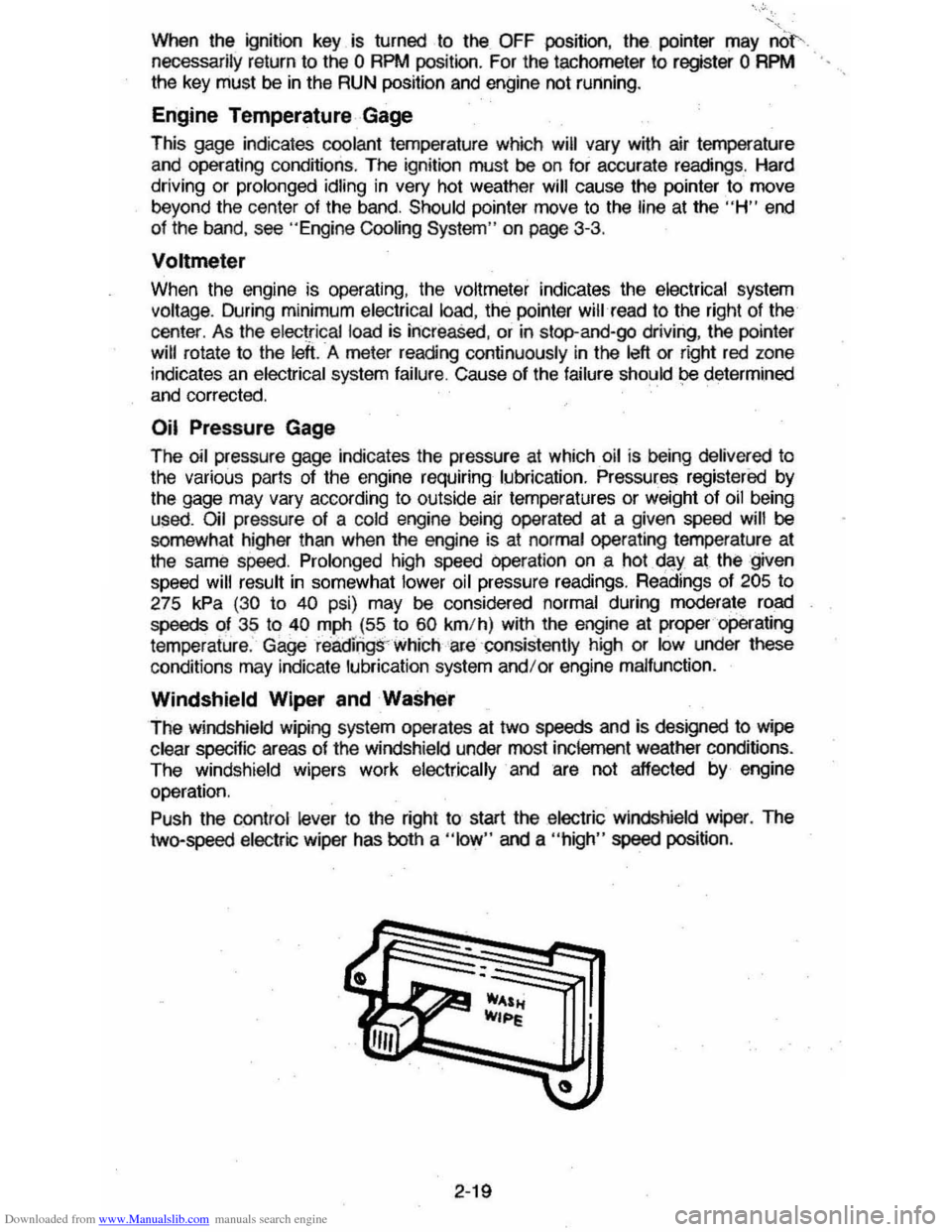
Downloaded from www.Manualslib.com manuals search engine When the ignition key is turned to the OFF position, the pointer may nO\". necessarily return to the 0 RPM position. For the tachometer to regster 0 RPM .
the key
must be in the RUN position and engine not running.
Engine Temperature Gage
This gage indicates coolant temperature which will vary with air temperature
and operating
cond~ions. The ignition must be on for accurate readings. Hard
driving
or prolonged idling in very hot weather will cause the pointer to move
beyond the center of the band. Should pcinter move to the line at the "H" end
of the band , see "Engine Cooling
System" on page 3-3.
Voltmeter
When the engine is operating, the voltmeter indicates the electrical system
voltage. During minimum electrical load, the pointer will read
to the right of the
center. As the electrical load is
increaSed, or in stop-and-go driving, the pointer
will rotate to the
left . A meter reading continuously in the left or right red zone
indicates an electrical system failure. Cause of the failure should be determined
and corrected.
Oil Pressure Gage
The oil pressure gage indicates the pressure at which oil is being delivered to
the various parts of the engine requiring lubrication. Pressures registered by the gage may vary according to outside air temperatures or weight of oil being
used. Oil pressure
of a cold engine being operated at a given speed will be
somewhat higher than when the engine is at normal operating temperature at
the same speed. Prolonged high speed operation on a hot day at the given
speed will result
in somewhat lower oil pressure readings. Readings of 205 to
275 kPa (30 to 40 psi) may be considered normal during moderate road
speeds of 35 to 40 mph (55 to 60 km/h) with the engine at proper operating
temperature . Gage readi'rig;rwhich are ·consistently high or low under these
conditions may indicate lubrication system and/or engine malfunction.
Windshield Wiper and Washer
The windshield wiping system operates at two speeds and is designed to wipe
clear
specijic areas of the windshield under most inclement weather conditions.
The windshield wipers work electrically and are not affected by engine
operation .
Push the control lever to the right to start
the electric windshield wiper. The
two-speed electric wiper has both a "low " and a "high " speed position .
2-19
Page 41 of 104
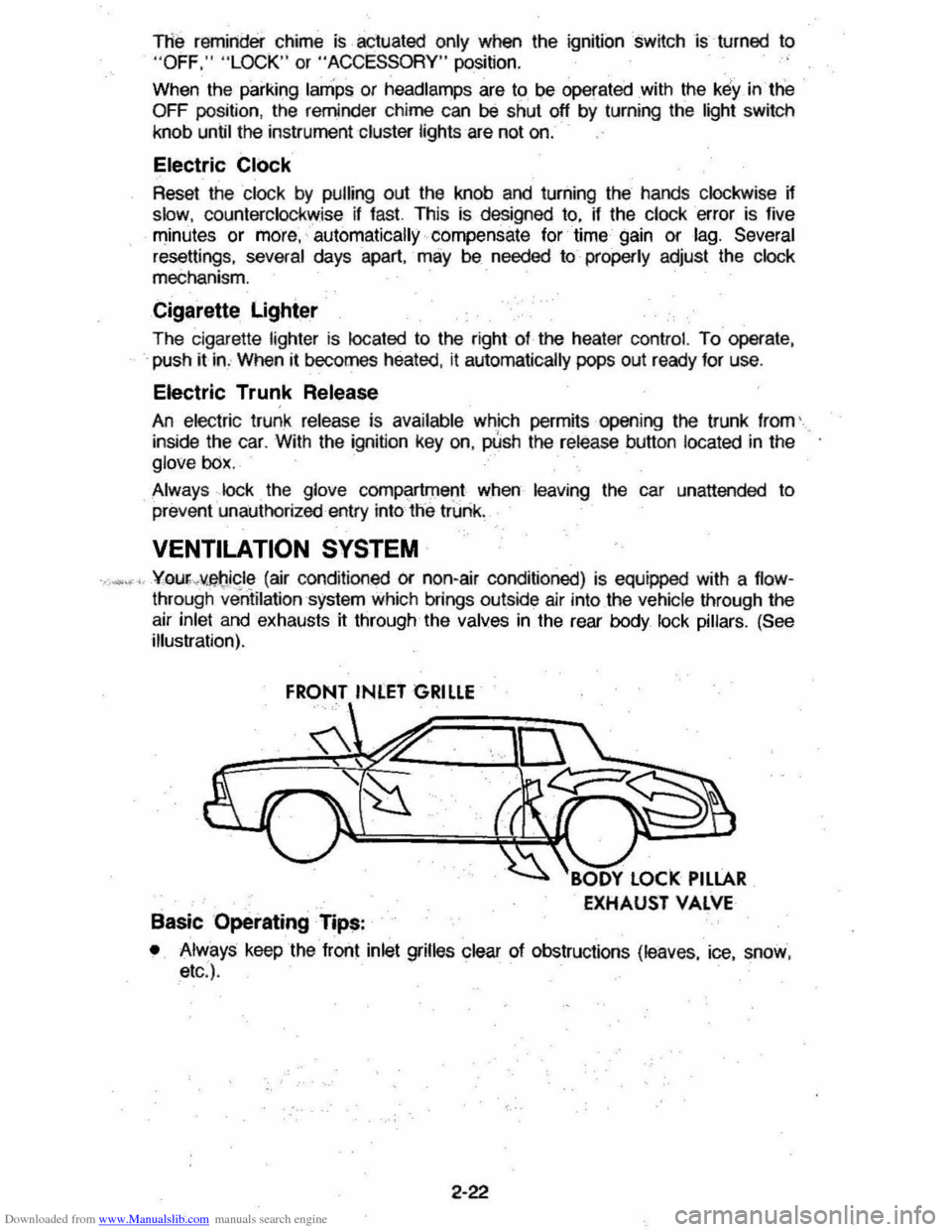
Downloaded from www.Manualslib.com manuals search engine The reminder chime is actuated only when the ignition -switch is--turned to
"OFF," "LOCK" or "ACCESSORY" position,
When the parking lamps or headlamps are
to be operated with the key in the
OFF position , the reminder chime can be shut off by turning the light switch
knob until the instrument cluster lights are not on.
Electric Clock
Reset the dock by pulling out the knOb and turning the hand s clockwise ~
slow, counterclockwise if fast. This is designed to, if the clock error is five minutes or mo"e~ -automatically --'compensate for time gain or ,lag. Several
resettings, several days apart, may be needed to properly adjust the clock
meChanism.
Cigarette Lighter
The cigarette lighter is located to the right of the heater control. To operate,
. push it in. When it becomes heated, it
automatically pops out ready for use .
Electric Trunk Release
An electric trunk release is available which permrts opening the trunk from'
inside the car. With the ignition key on, pUsh the release button located in the .
glove box.
Always
lock . the glove compartment when leaving the car unattended to prevent unauthorized entry into·tne trurik .
VENTILATION SYSTEM
.• _<, YOUf.,v.~Jc.le (air conditioned Of non -air conditioned) is equipped with a flowthrough ventilation system which brings outside air into the vehicle through the
air inlet a
nd exhausts it through the valves in the rear body lock pillars. (See
illustration).
FRONT INLET GRILLE
Basic Operating Tip!!:
• Always keep the front inlet grilles clear of obstructions (leaves, ice, snow ,
etc .) .
2-22
Page 42 of 104
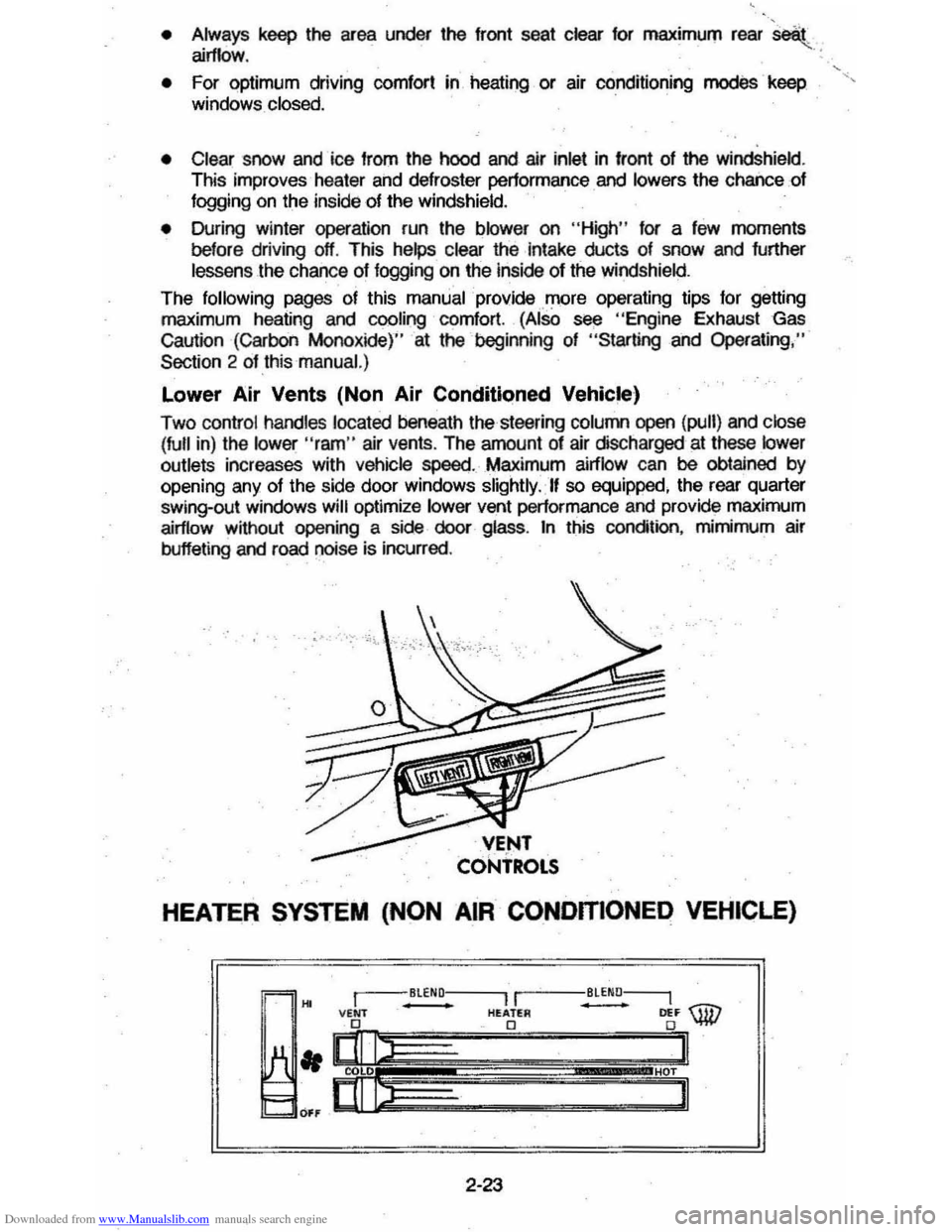
Downloaded from www.Manualslib.com manuals search engine • Always keep the area under the front seat clear for maximum rear seat airflow . .: ,
• For optimum driving comfort in. heating or air conditioning modes keep ", windows . closed. .
•
Clear snow and ice from the hood and air inlet in front of the windshield . This improves heater ahd defroster performance and lowers the chance of
fogging
on the inside of the windshield.
• During winter operation
run the blower on "High" for a few moments
before driving off. This helps clear the Intake ducts of snow and further
lessens the chance of fogging on the insiele of the windshield.
The following pages of this manual proviele more operating tips for getting
maximum heating
and cooling comfort. (AlsO s"" "Engine Exhaust Gas Caution (Carbon Monoxidej"at the beginning of "Starting and Operating ."
Section 2 oHhismanual.)
Lower Air Vents (Non Air Conditioned Vehicle)
Two control handles located beneath the steering colulTYl open (pull) and ciose
(full in) the
lower "ram" air vents . The amount of air discharged at these lower
outlets increases with vehicle speed. Maximum airflow can be obtained by
opening any of the side door windows slightly. If so equipped, the rear quarter SWing-out windows will optimize lower vent performance and provide maximum
airflow without opening a siele dIoor glass. In this condition, mimimum air
buffeting
and road noise is incurred .
HEATER SYSTEM (NON AIR CONDITIONED VEHICLE)
2-23
Page 43 of 104
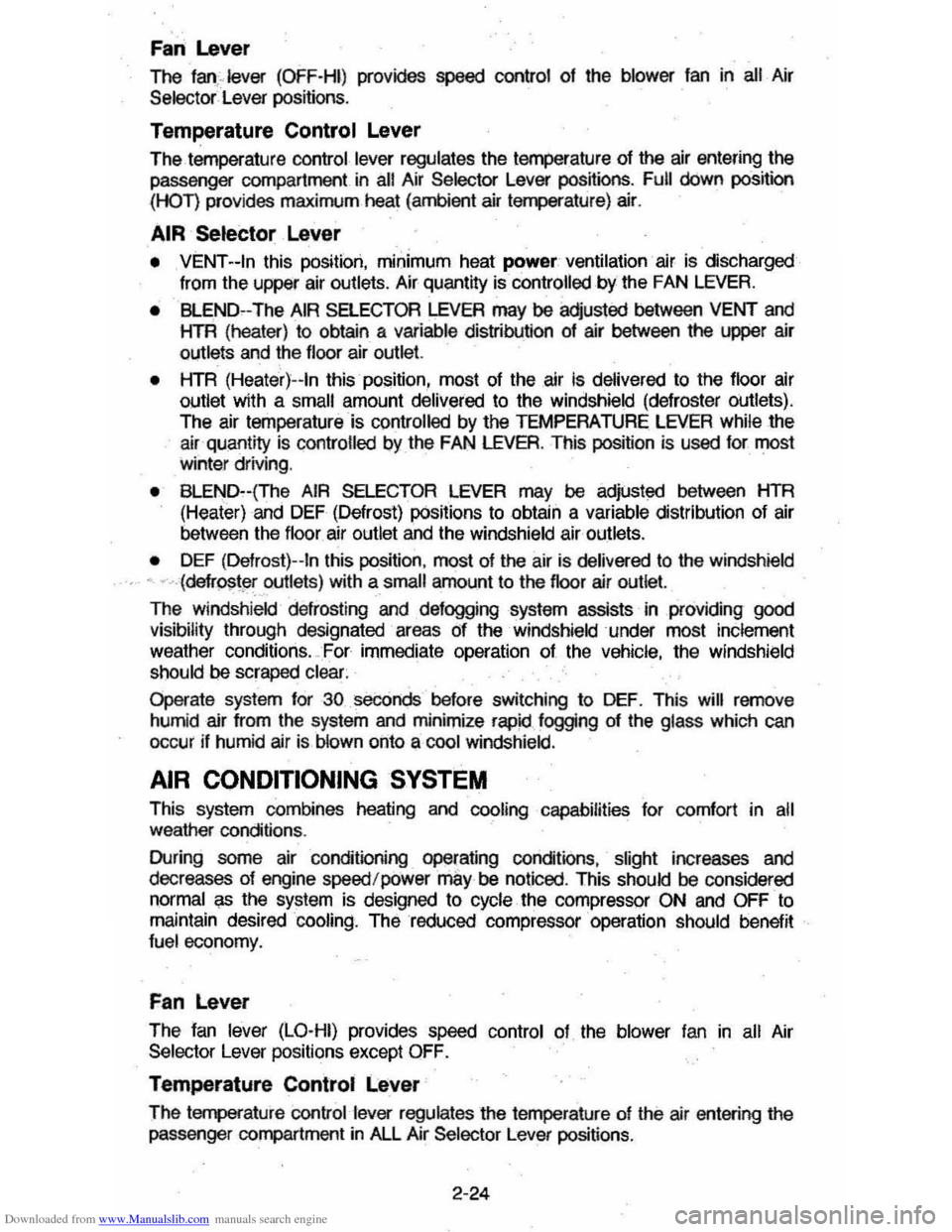
Downloaded from www.Manualslib.com manuals search engine Fan Lever
The fan;-lever (OFF-HI) provides speed control of the blower fan in all Air
Selector Lever positions.
Temperature Control Lever
The temperature control lever regulates the temperature of the air entering the passenger compartment in all Air Selector lever positions. Full down position
(HOT) provides maximum heat
(ambient air temperature) air.
AIR Selector Lever
• VENT --In this pOSition, minimum heat power. ventilation air is discharged
from the upper air oullets. Air quantity is
controlled by the FAN LEVER.
• BlEND_-The AIR SELECTOR LEVER may be adjusted between VENT and HTR (heater) to obtain a variable distribution of air between the uppe r air
outlets and the floor air outlet
• HTR (Heater )--In this position , most of the .air Is delivered to the floor air
outlet with a small amount deliVered to the windshield (defroster oullets).
The air temperature is
cpntrolled by the TEMPERATURE LEVER while the
air quantity is controlled by the FAN LEVER. This position is used for most winter driving. .
• BlEND--(The AIR SELECTOR LEVER may be adjUsted between HTR
(Heater) and DEF (Defrost) pOSitions to obtain a variable distribution of air
between the floor . air outlet
and the windshield air outlets.
• DEF (Defro st)--In this position , most of the air is delivered to the windshield
• ··-.(defrjl$t"routletS) with a small amount to the floor air outlet
The windsh ield de frost i
ng and defogging system assists in providing good
visibility through designated areas Of the windshield under most inclement
weather conditions. _For immediate operation of the vehicle, the windshield
should be scraped clear.
Operate system for
30 seconds before switching to DEF. This will remove
humid air from the system and minimize
rapid fogging of the glass which can occur jf humid air i s blown onto a cool windshield.
AIR CONDITIONING SYSTEM
This system combines heating and cooling capabilities for comfort in all
weather conditions .
During some air conditioning operating conditions , slight increases and
decreases of engine speedfpower may be noticed . This should be considered
normal as the system is designed to cycle the compressor ON and OFF to
maintain desired cooling. The reduced compressor operation should benefit
fuel economy.
Fan Lever
The Ian lever (LO-HI) provide s speed control of the blower fan in all Air Selector Lever positions except OFF.
Temperature Control Lever
The temperature control lever regulates the temperature of the air entering the
passenger compartment in ALL Air Selector Lever positions.
2-24
Page 44 of 104
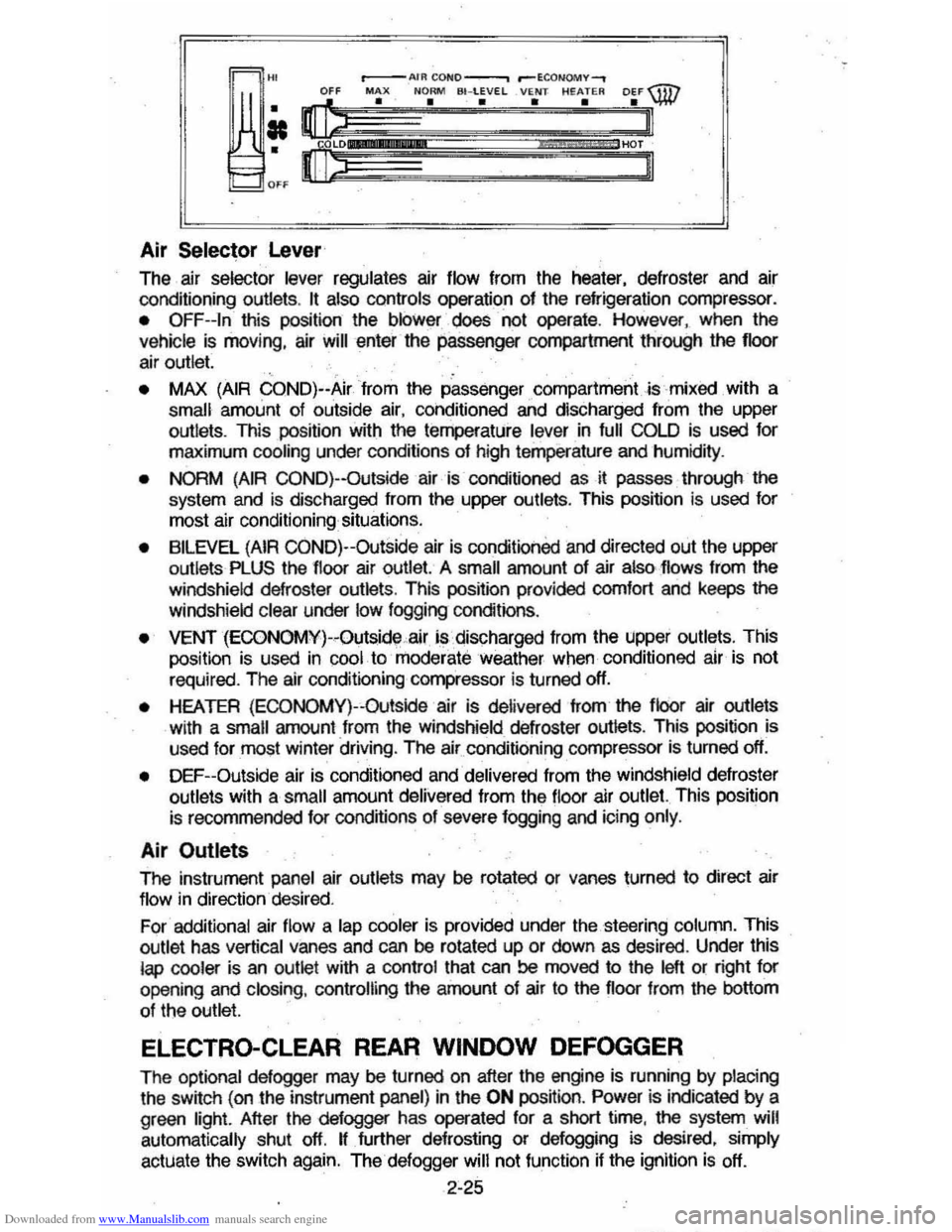
Downloaded from www.Manualslib.com manuals search engine Air Selector Lever
The air selector lever regulates air flow from the heater, defroster and air
conditioning outlets. It also controls operation of the refrigeration compressor.
• OFF--In this position the blower doeS not operate . However , when the
vehicle is moving, air will enter the passenger compartment through the floor
air outlet.
• MAX (AIR COND)--Air from the p~ssengercompartment is· mixed with a
small amount of outside air, conditioned and discharged from the upper
outlets. This position with the
temperature lever in full COLD is used for
maximum cooling under conditions
of high temperatu re and humidity .
• NORM (AIR COND) --Outside air is conditioned as it passes through the
system and is discharged from the upper outlets. This position is used for
most air conditioning situations.
• BILEVEL (AIR COND)--Outside air is conditioned and directed out the upper
outlets PlUS the floor air outlet. A small amount of air also flows trom the
windshield defroster outlets.
This position provided comfort and keeps the
windshield clear under low fogging conditions .
• VENT (ECONOMY)--Outsid~,air is discharged from the upper outlets. This position is used in cool. to moderate weather when· conditioned air· is not
required. The air conditioning compressor is turned off.
• HEATER (ECONOMY)-'-Outside air is delivered from the floor air outlets
with a small amount from the windshield defroster outlets. This position is
used for most winter driving. The air conditioning compressor is turned off.
• DEF--Outside air is conditioned and delivered from the windshield defroster
outlets with a smail amount delivered from the floor air outlet. This position
is recommended for conditions
Of severe fogging and icing only.
Air Outlets
The instrument panel air outlets may be rotated or vanes turned to direct air flow in direction' desired.
For additional air flow a lap cooler is provided under the steering column. This outlet has vertical vanes and can be rotated up or down as desired . Under this
lap cooler is an outlet with a control that can
be moved to the IefI or right for
opening and closing , controlling the amount of air
to the floor from the bottom
of the outlet.
ELECTRO-CLEAR REAR WINDOW DEFOGGER
The optional defogger may be turned on after the engine is running by placing
the switch (on the instrument panel) in the
ON postlion . Power is indicated by a
green light. After the defogger has operated for a short time, the system will
automatically
shut off. If further defrosting or defogging is des ired, simply
actuate the switch again.
The defogger will not function if the ignition is off.
2-25
Page 52 of 104

Downloaded from www.Manualslib.com manuals search engine Chevrolet's turbocharger incUles a "TlI'bo Control Center," which is an
electronic,
closed- loop, high energy spark control system that permits the use
of today's compression ratios with unleaded fuels. It works to control spark and
provide
good driveability. H automatically compensates for fuel octane,
atmospheric conditions,
load, and .other driving conditions, by continually monitoring engine detonation and adjusting the spark.
Are There Any Tricks To Driving A Turbocharged V-61
No, riot at all. Starting procedures are as covered on Page 2-8.
As with any normal engine, the turbocharged engine should not be run at
excessive
RPM immediately upon starting or shut down abruptly after running
at high
speeds.
Trailer
Towing: It should be noted that the Turbo V-6 engine uses advanced
electronic technology to provide a combination of performance and fuel
economy under most operating conditions, including driving in high-altitude
areas . Uke 'most V-6 engines, ~is su~abIe for pul~ng light-dutytrailers up to
450 kilograms (1,000 pounds) gross weight. However, the system was not
engineered for the rigors of towing
heavytraii
specffic recommendations) .
Don't Attempt Do-tt-Yourself Fixes: The turbocharger has but a handful of
parts, but since it is precision-manufactured with some tolerances as fine as
1/1 ,000,000 of an inch, maintenance and repairs should be done by an
authorized Chevrolet dealer or other qualified service outlet which
regularly
does such servk:e.
Catch Trouble Before . It Becomes Major: The turbocharger is an integral part
of your engine and not ar\'add-on .device.1f you spot an oil leak or hear an
unusual sound coming from the turbocharger , take it
In for service immediately .
The trouble may be simple to correct, but if allowed to continue, may
necessitate a more costly repair.
Normaf Scheduled Maintenance -
with Two Exceptions: The recommended
maintenance for the turbocharged
V -6 engine is shown in the General Motors
Maintenance
Schedule found in the glove compartment of your Chevrolet. The
turbocharged engine requires basically the same maintenance as a regular V-6
with two ",xceptions :
Engine Oil Change -every 3,000 miles.
Oil Filter Change -every 3,000 miles .
2-33